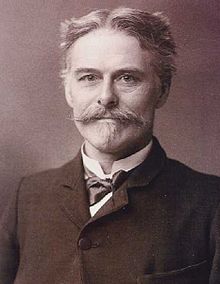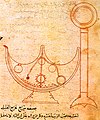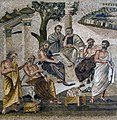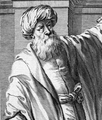Portal:History of science
The History of Science Portal
The history of science covers the development of science from ancient times to the present. It encompasses all three major branches of science: natural, social, and formal. Protoscience, early sciences, and natural philosophies such as alchemy and astrology during the Bronze Age, Iron Age, classical antiquity, and the Middle Ages declined during the early modern period after the establishment of formal disciplines of science in the Age of Enlightenment.
Science's earliest roots can be traced to Ancient Egypt and Mesopotamia around 3000 to 1200 BCE. These civilizations' contributions to mathematics, astronomy, and medicine influenced later Greek natural philosophy of classical antiquity, wherein formal attempts were made to provide explanations of events in the physical world based on natural causes. After the fall of the Western Roman Empire, knowledge of Greek conceptions of the world deteriorated in Latin-speaking Western Europe during the early centuries (400 to 1000 CE) of the Middle Ages, but continued to thrive in the Greek-speaking Byzantine Empire. Aided by translations of Greek texts, the Hellenistic worldview was preserved and absorbed into the Arabic-speaking Muslim world during the Islamic Golden Age. The recovery and assimilation of Greek works and Islamic inquiries into Western Europe from the 10th to 13th century revived the learning of natural philosophy in the West. Traditions of early science were also developed in ancient India and separately in ancient China, the Chinese model having influenced Vietnam, Korea and Japan before Western exploration. Among the Pre-Columbian peoples of Mesoamerica, the Zapotec civilization established their first known traditions of astronomy and mathematics for producing calendars, followed by other civilizations such as the Maya.
Natural philosophy was transformed during the Scientific Revolution in 16th- to 17th-century Europe, as new ideas and discoveries departed from previous Greek conceptions and traditions. The New Science that emerged was more mechanistic in its worldview, more integrated with mathematics, and more reliable and open as its knowledge was based on a newly defined scientific method. More "revolutions" in subsequent centuries soon followed. The chemical revolution of the 18th century, for instance, introduced new quantitative methods and measurements for chemistry. In the 19th century, new perspectives regarding the conservation of energy, age of Earth, and evolution came into focus. And in the 20th century, new discoveries in genetics and physics laid the foundations for new sub disciplines such as molecular biology and particle physics. Moreover, industrial and military concerns as well as the increasing complexity of new research endeavors ushered in the era of "big science," particularly after World War II. (Full article...)
Selected article -

The Tychonic system (or Tychonian system) is a model of the universe published by Tycho Brahe in 1588, which combines what he saw as the mathematical benefits of the Copernican system with the philosophical and "physical" benefits of the Ptolemaic system. The model may have been inspired by Valentin Naboth and Paul Wittich, a Silesian mathematician and astronomer. A similar cosmological model was independently proposed in the Hindu astronomical treatise Tantrasamgraha (c. 1500 CE) by Nilakantha Somayaji of the Kerala school of astronomy and mathematics.
It is conceptually a geocentric model, or more precisely geoheliocentric: the Earth is at the centre of the universe, the Sun and Moon and the stars revolve around the Earth, and the other five planets revolve around the Sun. At the same time, the motions of the planets are mathematically equivalent to the motions in Copernicus' heliocentric system under a simple coordinate transformation, so that, as long as no force law is postulated to explain why the planets move as described, there is no mathematical reason to prefer either the Tychonic or the Copernican system. (Full article...)
Selected image

Francis Galton was an English polymath known for his work in heredity, eugenics, and statistics. This photograph of Galton (age 73) was created upon his visit to Alphonse Bertillon's anthropometry laboratory in 1893. It serves as a good example of Bertillon's identification technology, which intended for the prosecution of criminals. Ironically, fingerprinting, a technique Galton transformed into a rigorously scientific one, eventually replaced Bertillon's system.
Did you know
...that the word scientist was coined in 1833 by philosopher and historian of science William Whewell?
...that biogeography has its roots in investigations of the story of Noah's Ark?
...that the idea of the "Scientific Revolution" dates only to 1939, with the work of Alexandre Koyré?
Selected Biography -
Edward Drinker Cope (July 28, 1840 – April 12, 1897) was an American zoologist, paleontologist, comparative anatomist, herpetologist, and ichthyologist. Born to a wealthy Quaker family, he distinguished himself as a child prodigy interested in science, publishing his first scientific paper at the age of 19. Though his father tried to raise Cope as a gentleman farmer, he eventually acquiesced to his son's scientific aspirations.
Cope had little formal scientific training, and he eschewed a teaching position for field work. He made regular trips to the American West, prospecting in the 1870s and 1880s, often as a member of U.S. Geological Survey teams. A personal feud between Cope and paleontologist Othniel Charles Marsh led to a period of intense fossil-finding competition now known as the Bone Wars. Cope's financial fortunes soured after failed mining ventures in the 1880s, forcing him to sell off much of his fossil collection. He experienced a resurgence in his career toward the end of his life before dying on April 12, 1897. (Full article...)
Selected anniversaries
- 1706 - Birth of Émilie du Châtelet, French mathematician and physicist (d. 1749)
- 1778 - Birth of Sir Humphry Davy, English chemist and physicist (d. 1829)
- 1835 - Birth of Alexander Emanuel Agassiz, American scientist; son of Louis Agassiz
- 1900 - Birth of Mary Cartwright, English mathematician (d. 1998)
- 1907 - Death of William Thomson, 1st Baron Kelvin, Irish-born physicist (b. 1824)
- 1908 - Birth of Willard Frank Libby, American chemist, Nobel laureate (d. 1980)
- 1920 - Birth of Kenneth E. Iverson, Canadian computer scientist (d. 2004)
- 1940 - Death of Alicia Boole Stott, Irish mathematician (b. 1860)
- 1964 - Death of Victor Franz Hess, Austrian-born physicist, Nobel laureate (b. 1883)
Related portals
Topics
General images
Subcategories
Things you can do
Help out by participating in the History of Science Wikiproject (which also coordinates the histories of medicine, technology and philosophy of science) or join the discussion.
Associated Wikimedia
The following Wikimedia Foundation sister projects provide more on this subject:
-
Commons
Free media repository -
Wikibooks
Free textbooks and manuals -
Wikidata
Free knowledge base -
Wikinews
Free-content news -
Wikiquote
Collection of quotations -
Wikisource
Free-content library -
Wikiversity
Free learning tools -
Wiktionary
Dictionary and thesaurus









































































